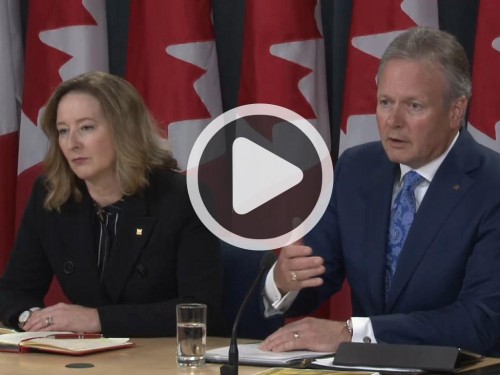Release of the Financial System Review
Good morning. Senior Deputy Governor Wilkins and I are glad to be with you today to talk about the June issue of the Bank’s Financial System Review (FSR), which we published this morning.
Let me start with a quick reminder about the purpose of the FSR. It identifies vulnerabilities in the financial system—pre-existing conditions that can interact with economic shocks—and monitors how they are evolving. It also looks at the potential impact on the financial system and economy if a shock were to interact with, and be magnified by, these vulnerabilities.
Canada’s financial system remains resilient, and this resilience has increased because the Canadian economy has strengthened since our previous FSR in December. Still, the two most important vulnerabilities for Canada’s financial system—the elevated level of household indebtedness and imbalances in the Canadian housing market—have moved higher over the past six months.
On the first, the level of household indebtedness in Canada continues to rise. A good portion of this increased debt consists of mortgages and home equity lines of credit located in the greater Toronto and Vancouver Areas.
Last year, the federal government introduced changes to housing finance policies aimed at improving the quality of borrowing. And there is evidence that these changes are working. This is particularly true for insured mortgages, where more than 80 per cent of the cost of the home is being borrowed. We have seen a drop in the proportion of insured mortgages being issued to highly indebted borrowers, that is, people whose debts are more than 450 per cent of their income. This is a positive development.
However, we are now seeing more uninsured mortgages being issued, particularly in places such as Toronto and Vancouver, where prices are the highest in Canada. In part, this is to be expected, given that insurance is not available for mortgages on homes with a price greater than $1 million. Still, some of these uninsured mortgages are showing riskier characteristics. A growing share is going to people who are highly indebted, and these borrowers are amortizing the mortgages over longer periods. As well, we see some evidence that people are borrowing from other sources to put together enough of a down payment to avoid the insurance requirement. This could be a concern, depending on the source of the borrowing.
Imbalances in housing markets, the second vulnerability, have also grown since December. Policies aimed at cooling the Greater Vancouver Area market appear to have had only a temporary effect, as sales and prices are rising again. Similar policies have recently been implemented for the Greater Toronto Area (GTA). While the most recent average home sale price in the GTA has declined, that followed significant price acceleration over the previous year, across dwelling types. There is a map in the FSR showing that large price increases are now being seen across the region, from Niagara to Peterborough.
We expect macroprudential and housing policy measures to help mitigate this vulnerability over time. And I would point out that housing market fundamentals remain very strong in the greater Toronto and Vancouver areas, with solid growth in population and employment. However, fundamentals alone cannot explain the price movements we have seen, and there is evidence that extrapolative expectations continue to play an important role.
This is important because there is a greater chance of a correction when prices rise at a faster pace than fundamentals would imply. And where extrapolative expectations are at work, there is always a risk that expectations can turn quickly, amplifying the drop in prices.
So, given the evolution of these two vulnerabilities, the Bank looked at the most important risk scenarios for the Canadian economy. Specifically, we once again looked at a risk scenario where a severe recession triggers a correction in house prices. And we took a narrower look at a different risk scenario, where a house price correction in specific regional markets occurs on its own, rather than being caused by some external shock.
Under the first scenario, a severe recession would lead to widespread job losses and declining income, which would hurt highly indebted households in particular. The ensuing house price correction would worsen the impact of the recession, which could lead to widespread stress in the financial system and economy. The Canadian economy has been strengthening in recent months, so the chance of this scenario happening is decreasing. However, its impact could now be more severe because the underlying vulnerabilities have grown.
The second scenario we looked at involved a significant house price correction in the greater Toronto and Vancouver areas. Such a correction would hit the British Columbia and Ontario economies, affecting spending on housing and related goods and services. There would be some spillovers to other regions and sectors of the economy. Bank balance sheets would also be affected in this scenario, leading to tighter lending standards.
The likelihood of this second scenario occurring is greater than the first. However, its impact would be less severe, and we don’t anticipate that a house price correction would trigger the widespread rise in unemployment assumed in the first scenario.
Given recent events, some people might naturally wonder if there is a connection between the two vulnerabilities we’ve described and the situation at Home Capital. While we don’t generally discuss individual financial institutions, I can say our assessment is that the situation reflected firm-specific factors. The regulatory and supervisory system worked as it is designed to do, and we are not seeing signs of broader stress. Indeed, those recent events were a pretty clear indication of the resilience of Canada’s financial system as a whole.
Let me close by pointing out that the FSR includes a section that describes how we measure the resilience of the Canadian financial system. It shows that capital, leverage and liquidity ratios in the Canadian financial system are all well above regulatory minimums and have improved over the past year.
We are seeing early signs of a recovery in business investment. The process of adjustment to the oil price shock is mostly behind us, having been facilitated by the monetary policy actions we took in 2015. This improving economic backdrop will add to the resilience of Canada’s financial system. And as such, we decided to drop the risk of prolonged weakness in commodity prices from our risk assessment.
With that, Senior Deputy Governor Wilkins and I are happy to respond to your questions.

